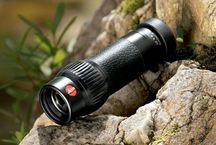Top 10 telescopes



The man has been looking at the sky since the times of the Neanderthals. Nowadays (more precisely, nights) it is not at all necessary to be the owner of your own observatory in order to see with your own eyes what is hidden in the sky from the unaided eye: the choice of good telescopes for the house is wide enough. In addition, there are much more interesting objects in the sky now than at the dawn of humanity: who among your friends can boast that he saw the ISS with his own eyes? Well, the telescope, though literally with one eye, will allow it.
The main thing is to choose a good telescope that corresponds to the set goal, both in design and in the quality of performance. In our latitudes, this is of particular importance: the best time to observe the starry sky is winter nights, so reliable protection against fogging and the general “frost resistance” of the telescope are simply obligatory.
Top telescope ranking in 2018 - Top 10
| Category | A place | Name | Rating | Price |
|---|---|---|---|---|
| The best refractor telescopes | 1 | Sky-Watcher BK 15012EQ6 SynScan GOTO | 10 / 10 | 199 990 |
| 2 | Celestron Omni XLT 120 | 9.7 / 10 | 44 975 | |
| 3 | BRESSER Classic 60/900 EQ | 9.5 / 10 | 17 430 | |
| The best reflex (mirror) telescopes | 1 | Sky-Watcher BK P2001 HEQ5 SynScan GOTO | 9.8 / 10 | 116 391 |
| 2 | LEVENHUK SkyMatic 135 GTA | 9.6 / 10 | 43 990 | |
| 3 | Meade StarNavigator NG 130mm | 9.4 / 10 | 38 605 | |
| Best Catadioptric Telescopes | 1 | Celestron CGEM II 1100 | 9.8 / 10 | 340 200 |
| 2 | Celestron NexStar 8 SE | 9.6 / 10 | 129 975 | |
| 3 | Sky-Watcher BK MAK102 AZ | 9.2 / 10 | 44 611 | |
| Top chromospheric telescopes | 1 | Sky-Watcher SolarQuest | 9.5 / 10 | 44 990 |
The best refractor telescopes
|
This telescope cannot be called cheap, but its class is much higher than that of low-cost models. A 150-mm lens with a four-layer illumination provides it with an excellent aperture ratio for the refractor telescope (f / 8.3), which will never be superfluous when observing the night sky. The maximum useful increase is 300 times. The main feature of the telescopes of this line, which in many respects determines the high price, is the auto-guidance and auto-tracking system, the motor drives are installed on both axes. It not only makes it easier to control the telescope when observed in direct presence, but also allows you to build a fully automatic astronomical station with a minimum of effort: amateur astronomers have been collecting such systems for a long time, and if at the beginning of the two thousandth they resembled articles made of "matches and acorns" now they can approach professional equipment in terms of accuracy and quality. It is especially convenient that the SynScan system regularly supports the management of digital SLR cameras, it can set shutter speed settings, continuous shooting. Even more precisely, the autoname system will become with an optional GPS module. The complete eyepieces are two, both are built according to the Pössl scheme (the writing of the Pössl is often found on the Internet incorrectly - look at the good old Brockhaus and Efron). If necessary, you will be able to purchase others as well, although for the majority of observations the standard kit is enough. But this telescope has one weighty minus, because of which we remembered for nothing about assembling an automatic astronomical station: it weighs decently (one pipe is more than 5 kilograms, and there is also a counterweight, and a steel tripod), so in transportation It is not very convenient. But, standing on a tripod, it stands due to the mass as a glove, and at high multiplicity it greatly affects the image quality and usability of the telescope. Main advantages:
Minuses:
|
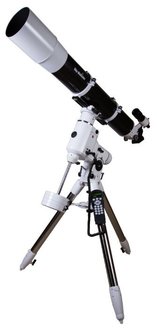 10 / 10
Rating
Reviews
To understand why they are taking such money, put it next to a cheap telescope and look at the eyepieces in turn - the difference is enormous. |
|
44 975
A sturdy “middling” with a 120-millimeter lens with a StarBright XLT brand antireflection coating and mounted on an equatorial mount CG-4 (honestly, the CG-5 suits this telescope much better, but, alas, it is not offered for this model).The relative aperture is f / 8.3, at the level of the much more expensive leader in the ranking of the best telescopes. The weight of the assembled telescope is 25 kg, so that it is still sufficiently transportable and well suited for both home and field trips. Maximum magnification - 283 krat. It would seem, not so much, but you should not repeat the traditional mistake of beginners, choosing a telescope by the multiplicity alone. But among the serious advantages of this model are minimal chromatic and spherical aberrations, and, according to many, they are lower than those of the twin brother SW BK 1201. Although he has a better EQ5 mount, we decided to include Celestron: the quality of optics is more important, and the “head” of the mount can be replaced if desired. Main advantages:
Minuses:
|
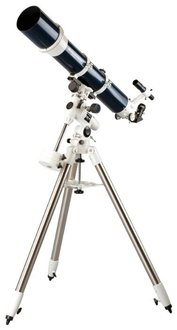 9.7 / 10
Rating
Reviews
Took on the advice of the forums, I really liked the telescope - to observe the planets is an excellent option. |
|
17 430
The most classic refractor telescope-achromat, which gave the name of this model. The purchase will definitely not disappoint you: its equipment is as versatile as possible, so the telescope “right out of the box” is useful for examining the details of lunar craters, and for “forays” into deep space - three eyepieces with different focal lengths are attached to it. In addition, the kit includes a diagonal mirror, convenient for observing objects in the zenith area. The range of magnifications - from 45 to 338 times. Not bad at all, but keep in mind that with a 60-millimeter lens, the luminosity of the telescope is not so great (f / 15). But it is inevitable victims in favor of low weight and transportability. To search for "target" is a five-fold optical finder with a 24-mm lens. To summarize: this model, convenient in transportation and easily assembled, will be a good “entry ticket” to astronomy for a reasonable amount. Well, then you will be able to decide for yourself: whether its capacity is enough, or is it time to collect a six-figure sum for a high-end model. Main advantages:
Minuses:
|
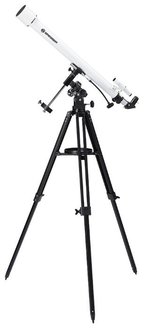 9.5 / 10
Rating
Reviews
An excellent telescope is darkish, but for many observations it suffices with a head. |
The best reflex (mirror) telescopes
|
Newtonian four-coaster reflector with a 200-mm aperture and an auto-guidance system SynScan will be able to please both image quality and capabilities. True, heating does not hurt him to collect: yet our winter nights are chilly for him. The mirror here is applied parabolic, giving excellent image clarity. Given the high luminosity (f / 5), you can count on the fact that the depths of the sky already studied by other telescopes will be able to reveal something new. Taking “into sight” distant galaxies at the maximum multiplicity, it can be understood that the stability of the mount is already not enough - including that is why we mentioned that you should not chase the multiplicity. But it cannot be said that it spoils the impressions of using a telescope. As for the auto-guidance / tracking system, we have already described it above, and there is no point in repeating it - here it is identical to that used on Sky-Watcher BK 15012EQ6 SynScan GOTO (oh, so it would be a mount here ...). Please note that thermal stabilization for this telescope (as well as for all reflectors with a massive mirror) is extremely important - you should immediately get acquainted with the proven solutions on the forums. Main advantages:
Minuses:
|
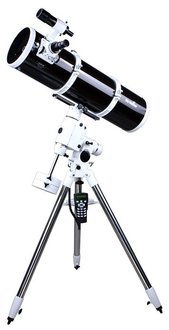 9.8 / 10
Rating
|
|
43 990
This telescope attracts a decent aperture (f / 5) and the presence of the system of auto-guidance for a fairly low price. Of course, the alt-azimuth mount used here has obvious drawbacks in the form of a “dead zone” around the zenith point: you can go through it only with a quick turn, which during astrophotography will cause the track to appear on the frame instead of the normal image. Therefore, this telescope will be more convenient first of all for observing and photographing static objects, but models with equatorial mount will be more interesting for shooting comets and meteor showers. Due to its popularity, this telescope model is already well studied in specialized forums, and it will not bring any “surprises”. The telescope has a well-known user: SkyMatic 135 GTA has been in Grand Ustyug at Santa Claus for 4 years already. Main advantages:
Minuses:
|
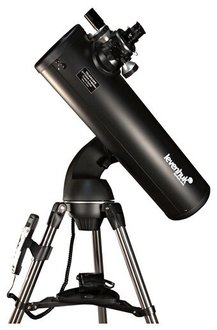 9.6 / 10
Rating
Reviews
In its class, one of the most interesting options for a novice astronomer - perhaps even the best. |
|
38 605
Although at the price, the Meade telescope almost catches up with Levenhuk, it is inferior in its characteristics: due to the smaller aperture, which, despite the “130 mm” in the marking, is only 102 mm, and the luminosity is lower - f / 7.7. On the other hand, the telescope is smaller and lighter: since reflex models are often chosen precisely for the convenience of transporting them, this can also be an important point when choosing. It also offers an auto-guidance system, and with a curious “excursion” function, when the telescope alternately locates various objects in the sky and talks about them. Alas, only in English. Main advantages:
Minuses:
|
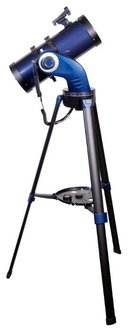 9.4 / 10
Rating
Reviews
Bought as a planetary - the same moon can be viewed in excellent detail. Both eyepiece quality liked. |
Best Catadioptric Telescopes
|
340 200
The most expensive telescope in our current rating (although, of course, there are models that have stepped beyond a million) will allow you to look into the most remote corners of the Universe - its maximum multiplicity is no less than 660 times. I am glad that the quality of the equatorial mount CGEM II meets the requirements that are inevitable on such approximations: the backlash is minimal, the speed of automatic control is high enough, and when electric motors operate, there is no “shaking" of the visual field. Of course, even with a 280-millimeter lens, the monstrous focal length of 2800 mm limits the aperture ratio - it is only f / 10, even despite the StarBright XLT multilayer illumination, the telescope is “darkish”. This is the inevitable price for high multiplicity. The autoneying system is definitely worth a try in business - it is easy to set up and functional, there is a quick update from a PC through a USB port. It is possible to tune the axes on a single star, and arbitrary: by capturing a star of sufficient brightness, the system will automatically calculate the correction of the polar axis. A drive error correction will ensure maximum pointing accuracy, which is very important for automated astrophotography at high multiplicity. We summarize: yes, the telescope is expensive, but its class also corresponds to the price. It is well suited for direct observation, and especially interested photographers. Main advantages:
Minuses:
|
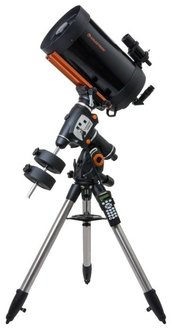 9.8 / 10
Rating
Reviews
Cool telescope, you can leave it for a few nights to take pictures and be sure that it will shoot exactly what you need. |
|
129 975
How about something cheaper? Well, if you do not chase the maximum magnification, which will also reduce the requirements for mounting precision, then why not look at the NexStar 8 SE telescope? Yes, his aperture is smaller than that of the top-end CGEM II 1100, the maximum approximation is smaller (480 times), but this is enough for amateur astronomy too much. But he, without losing the system of auto-guidance, no longer weighs more than 60 kilograms, but only 20 — and this, as they say in Odessa, is still two big differences! The system of guidance here, we note, is specific: even in manual mode, electric drives are still used (there are no mechanical verniers), so you should take care of good nutrition. Normally, it works from a set of AA batteries, but due to the fact that the total voltage of the unit is 12 volts, a much more capacious battery can be adapted. At the same time from it you will power both heating, and thermostabilization. Do not forget to warm up the remote control either: the LCD screen, as it should be, does not like low temperatures, starting to “brake” thoroughly. Main advantages:
Minuses:
|
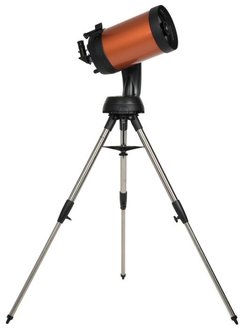 9.6 / 10
Rating
Reviews
For departures a good choice - it fits normally in the trunk of a hatchback, it is convenient to load and assemble. |
|
44 611
Our comparatively inexpensive “204-kratnik” rating, made according to the Maksutov-Cassegrain scheme, continues our rating of the best telescopes, weighs less than 10 kilograms and is excellent for regular “exits in the field”. At the same time, its azimuth mount has full auto-guidance, so that when taking photographs at high shutter speeds, it is not necessary to fear that a clear image will turn into a stretched track. The inevitable reckoning for compactness and low weight is the drop in luminosity due to the small aperture: the relative aperture is only f / 12.7. In addition, the bearing capacity of the mount is also small, so it is not suitable for mounting a heavy camera with a highly sensitive matrix: the telescope is more suitable for observing or photographing bright objects on a small camera or smartphone, choose a telescope with a better aperture and larger bearing capacity mount. Main advantages:
Minuses:
|
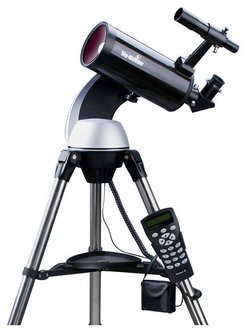 9.2 / 10
Rating
|
Top chromospheric telescopes
|
44 990
Specialized telescopes for observing the Sun are a specific thing, and not the most demanded, therefore there is not much choice in our market. Of the few models presented, the SolarQuest telescope is the most attractive of all, which is why it took the only position in this rating section in proud solitude. HelioFind Solar’s proprietary autoname system is as easy to use as possible: after switching on, the telescope is automatically guided to the Sun, after which it remains only to focus the optics - for that, you should thank the built-in GPS receiver and the three-axis accelerometer, thanks to which the system can automatically calculate the Sun’s position time for a particular place, even if the tripod is installed at some angle. The 70-mm lens does not provide the most impressive luminosity for this 140-kratnik (only f / 7), but just for chromospheric telescopes this is not so important: what, if anything, does the Sun have enough light. Therefore, not only small competition allowed us to give the telescope first place: it is in fact excellent for observing even the most complete beginners, and the more experienced amateur astronomers will not disappoint in quality. Main advantages:
Minuses:
|
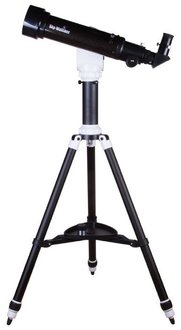 9.5 / 10
Rating
Reviews
Watching the Sun is really convenient and interesting. It is a pity that you can not remove the filter to turn into a conventional telescope - "protection against a fool." |
Which telescope is better to buy?
To be honest, a more or less detailed article about the features of various structures would require at times to inflate the volume of the article, so we are forced to go "tops".
Let's start with the optical scheme:
- Lens (refractor) telescopes, representing, in fact, a telescope-overgrown, simple in design, and therefore affordable. Requirements for thermal stabilization of their minimum of all designs. But the inevitable retribution for their high multiplicity is a considerable length, to increase the luminosity it is necessary to use lenses of large diameter, which ultimately makes the dimensions of the telescope unsuitable for transportation, and the requirements for mounting quality increase significantly.
- Reflex (mirror) telescopeswhich can be assembled according to several schemes, of which, nevertheless, the Newton scheme is the most popular one for more than one century bribes with much more compactness - their length is several times smaller than that of refractor ones having an equal focal length. Such telescopes are most often bought as portable. Their luminosity is higher than that of refractor ones, which means that they are better suited for viewing poorly luminous objects in the depths of space and astrophotography. But their price is also higher, the effect of temperature is more pronounced, adjustment is more difficult.
- Catadioptric telescopes - This is a kind of hybrid of the mirror and lens scheme. They are even more compact, and this scheme is great for telescopes of high multiplicity. The image quality is also higher than that of conventional reflex telescopes. But it is necessary to pay for it literally (in the store), and figuratively - the requirements for thermal stabilization are even higher, and adjustment is especially difficult.
Telescope mount is a node responsible for its movement relative to the tripod. It also provides the ability to automatically track the selected object on models with auto-homing, which is very useful, especially at high multiplicities: even the large planets of the Solar System will move to the field of view at a noticeable speed and disappear quickly from it. The easiest option is alt-azimuth mount, very similar to the camera mount on ordinary tripods. It is simple in design and easy to learn, but it has several disadvantages mentioned in the rating. More perfect equatorial mount already require some fuss at the beginning of work - you have to set the polar axis of the telescope. But it works great with objects moving in the area of the zenith, and tracking it is implemented kinematically easier. Its kinematics does not work only near the poles - you know that for amateur astronomers, this drawback does not matter.
In any case, for mounting, regardless of the type, minimum backlashes and precision of mechanisms are very important, otherwise, with a light touch, the tip will already “go away”, while moving, the field of view will shake. In the most complex mount control electronics takes into account even the backlash and uneven movement of mechanisms, but their price is very high. The mounts also have their own weight limitations - note that with astrophotography you will have to take into account the weight of the camera in order not to exceed the allowed threshold.
Have a good shopping!


